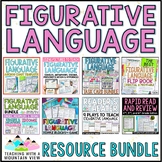Using Pictures to Teach Figurative Language | Figurative Language Lessons
- Zip
- Google Apps™

What educators are saying
Also included in
- Are you reading to take your skill-based reading comprehension instruction to the next level? Using Pictures to Teach and Review Reading Skills is a well-loved, teacher-approved method that has become a staple in classrooms across the globe.This huge, discounted bundle includes 90 printable (and DIGPrice $15.99Original Price $22.96Save $6.97
- Ready to master figurative language? This bundle of THIRTEEN figurative language lessons and activities for upper elementary will keep your students engaged as they master this tricky literacy topic. Which Figurative Language Activities are included in my purchase? Figurative Language Activities:FPrice $34.99Original Price $46.44Save $11.45
Description
Using Pictures to Teach Figurative Language allows you to teach and review figurative language using pictures AND teach students how to apply their skills to short reading passages!
With these 15 printable and digital pages, students will have the opportunity to:
- Observe a picture and make inferences, ask questions, make predictions, etc.
- Apply their knowledge of figurative language by choosing a sentence that correctly uses figurative language to describe the picture.
- Write their own examples of figurative language describing the picture
- Find examples of figurative language in a short passage.
The following types of figurative language are included:
- Similes
- Metaphors
- Personification
- Hyperbole
- Idioms
There are THREE printable pages for each skill (a total of 15 pages of figurative language practice).
There are four components to EACH page of this resource:
- Observe It: This section includes the picture with plenty of white space around it. The white space is for students to make literal AND inferential observations. Take as many notes as you can, encourage students to stretch their thinking, and watch their inference skills grow with EVERY picture you observe! Examples of observations are included.
- Choose It: In this section, students are required to choose a sentence that using figurative language to describe the picture. BE CAREFUL! These have been designed to include many different types of figurative language AND figurative language that does not make sense in the context of the picture.
- Write It: Students get to put their figurative language skills to the test and write their own examples for topics depicted in the picture!
- Apply It: This section has a short story that loosely relates to the same topic shown in the picture and requires students to pick out figurative language.
Why use pictures to teach reading skills?
I have thoughtfully designed these resources to align with best practices in reading comprehension instruction.
- This resource allows you to teach and review reading skills using pictures in an approachable, engaging, and easy-to-understand format.
- Applying reading skills to pictures requires students to think critically about the skill at hand.
- After using the picture to teach the skill, the resource transitions students to short tasks and reading passages where they apply the same skill in a different way.
- It prepares students for the cognitively demanding task of applying skills to authentic texts, such as picture books and novels.
- There is documented value in observing a picture and making inferences based on observations (and learning the difference between the two!), asking questions, making predictions, etc., and this resource does just that!
The Finer Details:
Printing: The images print well in color OR black and white. I do encourage you to project or show a color image for students so that they can make even more observations and inferences.
Answer Keys: I have included an answer key for each resource, but PLEASE NOTE: students should be encouraged to come up with their own original answers. Since many of the tasks are open-ended, there are many justifiable answers. These tasks are meant to encourage kids to think outside the box! You will be amazed at what they come up with.
Grouping Use: These printables are perfect for whole group or small group instruction, morning work, literacy centers, and more! I strongly suggest working through several of these pages as a whole group before allowing students to work independently on them-- particularly the "OBSERVE" section.
Grade Levels: Ideal for Grades 3+ and Enrichment or Whole-Class 2nd grade. I have personally used these with 2nd grade through 5th grade. The options are endless!
Digital and Projectable Access: In addition to the original printable version, there are TWO options for digital access for EACH of the four sets above. The original version that is identical to the printable pages is still included, but this resource also includes an interactive, easy-to-read and navigate Google Slides version! This digital version is also perfect for projecting as you teach a whole class lesson or small group.
This resource also includes a cover page to make this into a practice booklet, additional resource links to my SEVEN+ blog posts about using pictures to teach reading skills, and observation samples to help you teach the initial lessons.
I LOVE to incorporate pictures into my reading skill instruction! Visit my website www.teachingwithamountainview.com to see a plethora of blog posts and sample Using Pictures to Teach Reading Skills Anchor Charts!
I also use PICTURES to teach READING SKILLS!
I LOVE to incorporate pictures into my reading skill instruction! See MORE Picture Task Cards HERE!
Inference Text & Picture Task Cards







